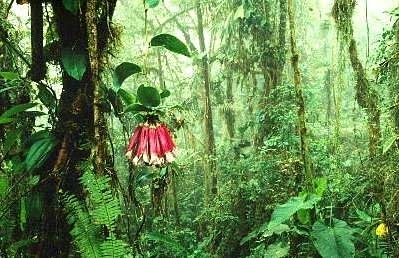Northwestern Andean montane forests
 Wild orchid (Cephalis sp.) approximately 1450m elevation, Northwestern Ecuador. Photograph by © WWF-Canon/Kevin Schafer The Northwestern Andean montane forests ecoregion is among the most diverse regions on Earth. The disjunct formation of Andean topography and pronounced glacial period of isolation forced plant and animal communities to adapt to different areas after being disconnected from each other; therefore laying the perfect foundation for speciation. For a gamut of reasons, related to their complex topography and a biogeographical history, featuring continual altitudinal migration of vegetation zones in response to the prehistorically changing climate, these ecosystems present a diverse array of distinctive biological communities, characterized by unusually high levels of species endemism.
Wild orchid (Cephalis sp.) approximately 1450m elevation, Northwestern Ecuador. Photograph by © WWF-Canon/Kevin Schafer The Northwestern Andean montane forests ecoregion is among the most diverse regions on Earth. The disjunct formation of Andean topography and pronounced glacial period of isolation forced plant and animal communities to adapt to different areas after being disconnected from each other; therefore laying the perfect foundation for speciation. For a gamut of reasons, related to their complex topography and a biogeographical history, featuring continual altitudinal migration of vegetation zones in response to the prehistorically changing climate, these ecosystems present a diverse array of distinctive biological communities, characterized by unusually high levels of species endemism.
This region not only boasts the highest biodiversity, but also the highest percentage of endemic species. About 50 percent of the ecoregion flora occur nowhere else, and this area contains the highest concentration of endemic bird areas; moreover, there are very high rates of amphibian endemism, notably in the robber frog genus. Unfortunately, people have found these areas livable and have disturbed these natural areas in many ways since pre-Colombian times. Although some reasonably sized continuous forest stands still exist, patchiness from farms and other anthropogenic influences have disturbed these highly sensitive forests.
Contents
Location and general description
The ecoregion is situated along the western slopes of the Andes Mountains down as far as the 200 meter elevation mark. The northern extent of the Northwestern Andean montane forests are found through northern Colombia and going as far south as almost the southern coast of Ecuador. Annual precipitation is quite high, rendering this ecoregion one of the wettest regions on Earth.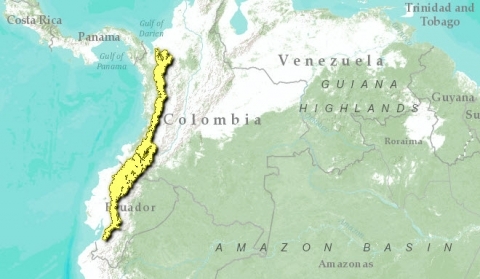
Biodiversity features
Within the Northwestern Andean montane forests ecoregion, flowering [[plant] species] manifest extreme biodiversity, and as many as 300 distinct [[plant] taxa] can be found inside a single hectare of the forest. At least 1178 vertebrate species have been recorded in the Northwestern Andean montane forests.
The ecoregion hosts a remarkable 86 taxa of palm trees, including two endemics: the feather palm and the endangered wax palm. There are numerous other notable species of the ecoregion including scores of endemic amphibians of the genus Pristimantis , many endemic treefrogs and a number of endemic amphibians of the genus Atelopus; moreover, other noteworthy vertebrate residents of these forests are the sword-billed hummingbird (Ensifera ensifera) and the Andean tapir (Tapirus pinchaque).
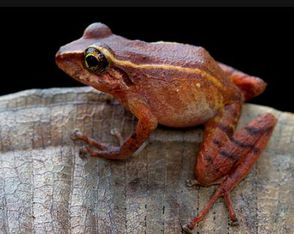 Pristimantis laticlavius. Source: Alejandro Arteaga/WWF There are numerous amphibian endemics in the Northwestern Andean montane forests especially in the genera Atelopus and Pristimantis: the Critically Endangered Antado stubfoot toad (Atelopus galactogaster), the Critically Endangered Pirri Range stubfoot toad (Atelopus glyphus), the Critically Endangered Rio Carauta stubfoot toad (Atelopus carauta), the Rio Faisanes stubfoot toad (Atelopus coynei), the Burrowes robber frog (Pristimantis laticlavius), the San Antionio robber frog (Pristimantis calcaratus), the cacao robber frog (Pristimantis cacao), the Urrao Cochran frog (Pristimantis johannesdei), the Rio Calima robber frog (Pristimantis diaphonus) the cachabi robber frog (Pristimantis achatinus), the Mantipus robber frog (Hypodactylus mantipus), the ocellated robber frog (Pristimantis ocellatus), the channel robber frog (Pristimantis sulculus), the Maldonado robber frog (Pristimantis loustes), the chiriboga robber frog (Pristimantis eremitus), the Ricuarte robber frog (Pristimantis scolodiscus), Duellman's robber frog (Pristimantis duellmani), the Pacific robber frog (Pristimantis appendiculatus), the cerro munchique robber frog (Pristimantis viridicans), the Jaime's robber frog (Pristimantis jaimei), the Palmer's robber frog (Pristimantis palmeri), the La Planada robber frog (Pristimantis apiculatus), the dwarf robber frog (Pristimantis hectus), the Porvenir robber frog (Pristimantis crucifer), the Rio Calles robber frog (Strabomantis cheiroplethus), the Tandapi robber frog (Pristimantis nyctophylax), the Zapadores robber frog (Pristimantis quinquagesimus), the white-striped robber frog (Pristimantis luteolateralis), the reserve robber frog (Pristimantis siopelus), the sharpsnout robber frog (Pristimantis acutirostris), the spurred robber frog (Pristimantis calcarulatus), the Valle robber frog (Pristimantis cabrerai), the Sobetes robber frog (Pristimantis sobetes), and the Uribe robber frog (Pristimantis molybrignus). Further Pristimantis genus endemics here that lack a common name are: Pristimantis aemulatus, Pristimantis albericoi, Pristimantis baiotis, Pristimantis capitonis, Pristimantis angustilineatus, Pristimantis aurantiguttatus, Cochranella cristinae, Pristimantis chrysops, Pristimantis deinops, Pristimantis diogenes, Pristimantis dissimulatus, Pristimantis eugeniae, Pristimantis illotus, Pristimantis juanchoi, Pristimantis kelephas, Pristimantis mars, Pristimantis myops, Pristimantis orpacobates, Pristimantis phalarus, Pristimantis platychilus, Pristimantis polychrus, Pristimantis pteridophilus, Pristimantis ptochus, Pristimantis quantus, Pristimantis restrepoi, Pristimantis ruedai, Pristimantis sanguineus, Pristimantis signifer, Pristimantis silverstonei, Pristimantis viridis, Pristimantis xylochobates.
Pristimantis laticlavius. Source: Alejandro Arteaga/WWF There are numerous amphibian endemics in the Northwestern Andean montane forests especially in the genera Atelopus and Pristimantis: the Critically Endangered Antado stubfoot toad (Atelopus galactogaster), the Critically Endangered Pirri Range stubfoot toad (Atelopus glyphus), the Critically Endangered Rio Carauta stubfoot toad (Atelopus carauta), the Rio Faisanes stubfoot toad (Atelopus coynei), the Burrowes robber frog (Pristimantis laticlavius), the San Antionio robber frog (Pristimantis calcaratus), the cacao robber frog (Pristimantis cacao), the Urrao Cochran frog (Pristimantis johannesdei), the Rio Calima robber frog (Pristimantis diaphonus) the cachabi robber frog (Pristimantis achatinus), the Mantipus robber frog (Hypodactylus mantipus), the ocellated robber frog (Pristimantis ocellatus), the channel robber frog (Pristimantis sulculus), the Maldonado robber frog (Pristimantis loustes), the chiriboga robber frog (Pristimantis eremitus), the Ricuarte robber frog (Pristimantis scolodiscus), Duellman's robber frog (Pristimantis duellmani), the Pacific robber frog (Pristimantis appendiculatus), the cerro munchique robber frog (Pristimantis viridicans), the Jaime's robber frog (Pristimantis jaimei), the Palmer's robber frog (Pristimantis palmeri), the La Planada robber frog (Pristimantis apiculatus), the dwarf robber frog (Pristimantis hectus), the Porvenir robber frog (Pristimantis crucifer), the Rio Calles robber frog (Strabomantis cheiroplethus), the Tandapi robber frog (Pristimantis nyctophylax), the Zapadores robber frog (Pristimantis quinquagesimus), the white-striped robber frog (Pristimantis luteolateralis), the reserve robber frog (Pristimantis siopelus), the sharpsnout robber frog (Pristimantis acutirostris), the spurred robber frog (Pristimantis calcarulatus), the Valle robber frog (Pristimantis cabrerai), the Sobetes robber frog (Pristimantis sobetes), and the Uribe robber frog (Pristimantis molybrignus). Further Pristimantis genus endemics here that lack a common name are: Pristimantis aemulatus, Pristimantis albericoi, Pristimantis baiotis, Pristimantis capitonis, Pristimantis angustilineatus, Pristimantis aurantiguttatus, Cochranella cristinae, Pristimantis chrysops, Pristimantis deinops, Pristimantis diogenes, Pristimantis dissimulatus, Pristimantis eugeniae, Pristimantis illotus, Pristimantis juanchoi, Pristimantis kelephas, Pristimantis mars, Pristimantis myops, Pristimantis orpacobates, Pristimantis phalarus, Pristimantis platychilus, Pristimantis polychrus, Pristimantis pteridophilus, Pristimantis ptochus, Pristimantis quantus, Pristimantis restrepoi, Pristimantis ruedai, Pristimantis sanguineus, Pristimantis signifer, Pristimantis silverstonei, Pristimantis viridis, Pristimantis xylochobates.
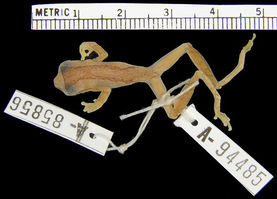 Pacific lowland treefrog, endemic to the ecoregion. Source: Harvard University/EOL Other amphibian endemics in this ecoregion are the Critically Endangered carchi Andes toad (Andinophryne colomai), the cauca caecilian (Caecilia occidentalis), the endangered cerro munchique marsupial frog (Gastrotheca trachyceps), the Vulnerable Rio Calima marsupial frog (Gastrotheca dendronastes), Lynch's cochran frog (Nymphargus ignota), the Near Threatened Urrao cochran frog (Cochranella megistra), the Mesopotamia beaked toad (Rhinella rostrata), the Santa Rita beaked toad (Rhinella macrorhina), the cotopaxi rocket frog (Colostethus fallax), the stripe throated rocket frog (Colostethus brachistriatus), the Lehmann's rocket frog (hyloxalus lehmanni), the Urrao rocket frog (Hyloxalus breviquartus), the executioner treefrog (Dendropsophus carnifex), Pacific lowland treefrog (Dendropsophus gryllatus), the western Andes treefrog (Hyla sarampiona), the Simmons treefrog (Hyloscirtus simmonsi), the Pilalo treefrog (Hyloscirtus ptychodactyla), the finca primavera rocket frog (Colostethus alacris), the Gunther's marsupial frog (Gastrotheca guentheri), the Vulnerable Tandapi giant glass frog (Centrolene peristictum), the Tandayapa Andes toad (Andinophryne ollalai), the western Andes toad (Andinophryne atelopoides), the Tandayapa giant glass frog (Centrolene scirtetes), the Critically Endangered Atelopis famelicus, the Critically Endangered Atelopis chocoensis, Anomaloglossus atopoglossus, Hyloxalus betancuri, Colostethus furviventris, Colostethus maquipucuna, Colostethus yaguara, the Vulnerable Gastrotheca antomia, Cochranella luminosa, Cochranella luteopunctata and Cochranella armata.
Pacific lowland treefrog, endemic to the ecoregion. Source: Harvard University/EOL Other amphibian endemics in this ecoregion are the Critically Endangered carchi Andes toad (Andinophryne colomai), the cauca caecilian (Caecilia occidentalis), the endangered cerro munchique marsupial frog (Gastrotheca trachyceps), the Vulnerable Rio Calima marsupial frog (Gastrotheca dendronastes), Lynch's cochran frog (Nymphargus ignota), the Near Threatened Urrao cochran frog (Cochranella megistra), the Mesopotamia beaked toad (Rhinella rostrata), the Santa Rita beaked toad (Rhinella macrorhina), the cotopaxi rocket frog (Colostethus fallax), the stripe throated rocket frog (Colostethus brachistriatus), the Lehmann's rocket frog (hyloxalus lehmanni), the Urrao rocket frog (Hyloxalus breviquartus), the executioner treefrog (Dendropsophus carnifex), Pacific lowland treefrog (Dendropsophus gryllatus), the western Andes treefrog (Hyla sarampiona), the Simmons treefrog (Hyloscirtus simmonsi), the Pilalo treefrog (Hyloscirtus ptychodactyla), the finca primavera rocket frog (Colostethus alacris), the Gunther's marsupial frog (Gastrotheca guentheri), the Vulnerable Tandapi giant glass frog (Centrolene peristictum), the Tandayapa Andes toad (Andinophryne ollalai), the western Andes toad (Andinophryne atelopoides), the Tandayapa giant glass frog (Centrolene scirtetes), the Critically Endangered Atelopis famelicus, the Critically Endangered Atelopis chocoensis, Anomaloglossus atopoglossus, Hyloxalus betancuri, Colostethus furviventris, Colostethus maquipucuna, Colostethus yaguara, the Vulnerable Gastrotheca antomia, Cochranella luminosa, Cochranella luteopunctata and Cochranella armata.
Endemic reptiles of the ecoregion include the Antiodlula anole (Anolis antioquiae), the O'shaughnessy's Anole (Anolis gemmosus), the saphenophis snake (Saphenophis sneiderni), the striped saphenophis snake (Saphenophis tristriatus), the Atahuallpa saphenophis snake (Saphenophis atahuallpa), the Bolivian whorltail iguana (Stenocercus bolivarensis), the Colombian blind snake (Anomolepis colombius), the equatorial anole (Anolis aequatorialis), the garagoa caecilian (Caecilia degenerata), Haensch's whorltail iguana (Stenocercus haenschi), hispanic ground snake (Atractus oculotemporalis), the western ground snake (Atractus occidentalis), the three striped tropical snake (Lygophis tristiatus), the tropical lightbulb lizard (Proctoporus oculatus), the grand scaly-eyed gecko (Lepidoblepharis grandis), Bothrocophias colombianus, Bothrops xanthogrammus, Bothrocophias campbelli,Saphenophis boursieri, Riama labionis, Riama vespertina, Synophis calamitus and Anolis megalopithecus.
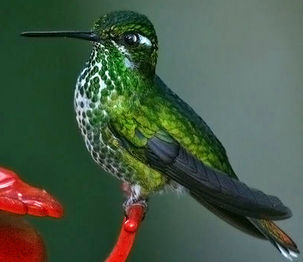 The endemic purple-billed whitetip. Source: David Cook/EOL Endemic birds of the Northwest Andean montane forests include the Critically Endangered colorful puffleg (Eriocnemis mirabilis),, the empress brilliant (Heliodoxa imperatrix), the Near Threatened fulvus treerunner bird (Margaromis stellatus), the black solitaire (Entomodestes corocinus), the gorgeted sunangel (Heliangelus strophianus), the blue-headed sapphire (Hylocharis grayi), the grayish picolet (Picumnus granadensis), the orange-banded flycatcher (Myiophobus lintoni), the Near Threatened hoary puffleg (Haplophaedia lugens), the Critically Endangered turquoise-throated puffleg (Eriocnemis godini), Pacific tuftedcheek (Pseudocolaptes johnsoni), the Critically Endangered pale-headed brush-finch (Atlapetes pallidiceps), the Near Threatened plate-billed mountain-toucan (Andigena laminirostris), the purple-billed whitetip (Urosticte benjamini), the violet-tailed sylph (Aglaiocercus coelestis) and the endangered violet-throated metaltail (Metallura baroni)
The endemic purple-billed whitetip. Source: David Cook/EOL Endemic birds of the Northwest Andean montane forests include the Critically Endangered colorful puffleg (Eriocnemis mirabilis),, the empress brilliant (Heliodoxa imperatrix), the Near Threatened fulvus treerunner bird (Margaromis stellatus), the black solitaire (Entomodestes corocinus), the gorgeted sunangel (Heliangelus strophianus), the blue-headed sapphire (Hylocharis grayi), the grayish picolet (Picumnus granadensis), the orange-banded flycatcher (Myiophobus lintoni), the Near Threatened hoary puffleg (Haplophaedia lugens), the Critically Endangered turquoise-throated puffleg (Eriocnemis godini), Pacific tuftedcheek (Pseudocolaptes johnsoni), the Critically Endangered pale-headed brush-finch (Atlapetes pallidiceps), the Near Threatened plate-billed mountain-toucan (Andigena laminirostris), the purple-billed whitetip (Urosticte benjamini), the violet-tailed sylph (Aglaiocercus coelestis) and the endangered violet-throated metaltail (Metallura baroni)
Endemic mammals of the ecoregion are represented by Sturnira mistratensis. The ecoregion boasts more than 400 total avian taxa, more than 90 frog species, about 120 mammal taxa' moreover, in excess of 200 different species of butterfly, populate the Cauca Valley highlands portion of the ecoregion.
This Northwestern Andean montane forests harbour the majority of the Earth's spectacled bear (Tremarctos ornatus) populations; this bear taxon is the only species of bear that occurs in Central and South America.
Current status

The conservation status of this ecoregion is classified as Vulnerable; moreover, the Northwestern Andean montane forests ecoregion is given a G200 designation, indicating it has the highest priority for conservation.
Types and severity of threats
The rapidly expanding human population of this region poses the greatest ecological threat to the Northwestern Andean montane forests. The region is under intense pressure from a growing human population due to agricultural land conversion for both crops and pasture, gathering wood for fuel and timber, mining operations, and deforestation, which leads to habitat loss and habitat fragmentation; the anurans of this ecoregion are particularly threatened by such habitat destruction. Continuing degradation of forest fragments is a further threat. Timber exploitation, illegal hunting, cattle ranching and coca production pose additional threats. There are no nature preserves or conservation projects protecting this ecoregion.
Justification of ecoregion delineation
These montane forests are delineated by elevational changes in vegetation. Lower elevation linework follows the 200 meter contour along the Pacific slope and was distinguished from neighboring montane forests by expert opinion at an ecoregion workshop on the Northern Andes (Bogota, Colombia, 24-26 July, 2000). These forests occur on the western slopes of the Andes from their origins in northern Colombia and extend southwards through Ecuador. At higher elevations delineation’s are drawn along the unique treeless páramo habitats, otherwise they are along the continental divide. In Ecuador reference was made to Sierra (1999). This ecoregion is host to many endemic species.
References and notes
- Complejo Ecoregional de los Andes del Norte (CEAN). Experts and ecoregional priority setting workshop. Bogota, Colombia, 24-26, July, 2000.
- Andres Cuervo. 2007. PersistentAssemblage and population-level consequences of forest fragmentation on bilateral asymmetry in tropical montane birds. Biological Journal of the Linnean Society; Vol. 92 Issue 1, pp.119-133
- Philip Keating. 2007. Fire Ecology and Conservation in the High Tropical Andes: observations from Northern Ecuador. Journal of Latin American Geography; Vol. 6 Issue 1, pp.43-62.
- Norman Myers. 2000. Biodiversity hotspots for conservation priorities. Nature. Vol.403. pp.853-858.
- Ken Norris. 2000. Extinction processes in hot spots of avian biodiversity and the targeting of pre-emptive conservation action. The Royal Society. Vol. 271. pp.123-130.
- Niall O'Dea. 2006. How well do Important Bird Areas represent species and minimize conservation conflict in the tropical Andes? Diversity & Distributions; Vol. 12 Issue 2, pp.205-214.
- R.Sierra. editor. 1999. Propuesta Preliminar de uns Sistema de Clasificación de Vegetación para el Ecuador Continental. Proyecto INEFAN/GEF-BIRF y EcoCiencia. Quito, Ecuador.
- Portions of this article were prepared by Brad Klein of the World Wildlife Fund.
